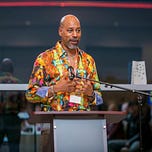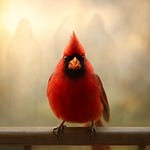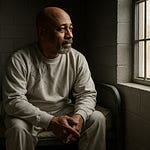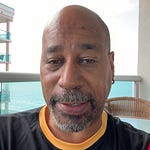Grief is not a sign of weakness. It's not something to be pushed away, buried, or avoided. Grief is an invitation. A challenge. Grief is a portal to something deeper.
In this profound episode of Grief 2 Growth, I sat down with Sifu Boggie, a Taoist guide and healer, to explore how ancient Taoist philosophy and energy medicine can help us reclaim our vitality, move through emotional pain, and connect to something far greater than ourselves.
Whether you’re new to Taoism or just starting to explore the mind-body-spirit connection, this conversation offers something powerful — not just inspiration, but practical tools for real-life healing.
🌿 What Is Taoism — And How Can It Help Us Heal?
Taoism (pronounced “Daoism”) is not a religion in the traditional Western sense. It doesn’t require a belief system, a deity, or even a guru.
As Sifu Boggie explains, Taoism is simply about “the Way” — finding balance, flow, and connection between your inner world and the world around you.
“Tao means path, balance, or way of being. It’s not a rulebook. It’s an observation of how life flows — and how you can align with it.” – Sifu Boggie
In Taoist thought, healing isn’t just about stopping symptoms. It’s about realigning yourself with nature’s rhythm — physically, emotionally, and energetically.
And believe it or not, you already know Taoism. If you’ve ever watched Star Wars, you’ve seen Taoist wisdom in action. The Force? That’s Qi — life energy. Light and dark? Yin and Yang.
🌀 Where Grief Lives: The Body-Mind-Energy Connection
When we experience loss, our instinct is to think it’s all in our mind or our heart. But grief is physical too.
According to Taoist philosophy, emotions store in the body — especially in the tendons and organs. Chronic tension in the shoulders might be “carrying the weight of the world.” Neck pain might signal a conflict between belief and action. Stiffness often shows up where grief has settled.
“When we contract emotionally, the body contracts physically. The muscles tense. The breath shortens. The energy flow stops.” — Sifu Boggie
The healing begins when we move. Not just emotionally, but physically.
🧬 The Power of Belief: Epigenetics, Placebo & Nocebo
Science is catching up to what ancient Taoists have known for centuries: your thoughts and emotions directly affect your health.
We talked about epigenetics, the study of how your beliefs and emotions can switch genes on or off. In other words, your internal environment shapes your physical reality.
And then there's the placebo effect. Studies show that when people believe they’re receiving treatment — even if it’s a sugar pill or a fake surgery — up to 80% get better.
“If you believe something’s going to work, it probably will. That’s not just psychology — it’s biology.” — Brian D. Smith
The dark side? The nocebo effect. If you believe something won’t work — even if it’s a proven treatment — it might not.
Bottom line: What you believe matters. Tremendously.
🧘 What Is Qigong — And Why Does It Work?
Qigong (pronounced “chee-gong”) means “energy work” or “breath cultivation.” It’s a form of gentle, flowing movement designed to restore balance to your energy system.
Unlike intense workouts, Qigong calms the nervous system while stimulating internal healing.
“Tai Chi is a type of Qigong. If you’ve ever seen people moving slowly in the park, you’ve seen it. But Qigong can be as simple as breathing while gently swaying your arms.” — Sifu Boggie
It’s not about burning calories. It’s about releasing stagnation — emotional, physical, energetic.
Regular Qigong practice can:
Reduce anxiety and stress
Improve sleep
Release grief stored in the body
Rebalance hormones and immune response
And yes — it’s accessible to anyone, even those with limited mobility.
🎠 Why Fidgeting Is Sacred: Movement as Medicine
We’re taught that sitting still is a virtue. That silence equals control. That healing looks like peace.
But Taoist wisdom (and neuroscience) tells us otherwise.
Children fidget because their bodies are intuitive. They move to release energy. When we’re forced to sit still, we suppress emotion, tension, and toxicity — literally.
“Movement isn’t just for muscles. It helps your organs function, keeps your energy flowing, and prevents stagnation.” — Sifu Boggie
This is why Sifu sits on a yoga ball. It encourages subtle movement throughout the day.
So next time you feel the urge to stretch, sway, or tap your foot — don’t stop yourself. That’s your body healing.
🌈 The Divine Child: Why Play is Part of Healing
Taoist teachings remind us that within each of us lives not just masculine and feminine energy — but the Divine Child.
This child is curious, imaginative, and fearless. It dreams big. It believes in “what if?”
Healing doesn’t always require a deep therapy session. Sometimes it looks like coloring, dancing, laughing, or knitting.
“You don’t have to meditate cross-legged on a mountaintop. If fishing, knitting, or puzzles calm your mind — you’re meditating.” — Sifu Boggie
And when you bring joy into your healing process, your brain learns to associate transformation with pleasure — not pain.
💀 What Taoism Teaches About Death and the Afterlife
Unlike many Western religions, Taoism doesn’t frame death as a judgment.
Instead, death is part of the eternal flow. Life transforms, energy moves, consciousness shifts. Nothing truly ends.
“We don’t disappear — we evolve. We flow back into the Tao, and perhaps return in another form. This life is not all there is.” — Sifu Boggie
Modern science echoes this. Quantum physics has shown that atoms are interconnected. Energy doesn’t die — it transforms.
Taoist sages believed we are like waves returning to the ocean. And if we understand that, we don’t have to fear grief. We can honor it — and grow through it.
🍞 Sifu’s Story: From Pastry to the Path
Sifu Boggie didn’t grow up in a temple. He was a bullied child in England. Then a police officer. Then a pastry chef.
But the Tao kept calling him — through martial arts, energy healing, and meditation. He eventually studied under Taoist masters and began guiding others as a modern-day barefoot doctor.
“Everything is connected. Even kneading dough helped me understand healing. It’s all energy work.” — Sifu Boggie
His life is proof that the Tao meets you where you are — and that your path doesn’t have to make sense to anyone else.
🛠️ Bringing It All Together: Tools You Can Use Today
Here are some simple practices inspired by Taoist principles that you can begin using immediately:
✅ Move Your Body Gently – Try a few minutes of Qigong, stretching, or swaying to music. Movement releases grief and boosts energy flow.
✅ Change Your Focus – When grief takes over, gently shift your focus to a memory that brings peace or gratitude.
✅ Play Daily – Reconnect with your inner child. Paint, doodle, cook without a recipe, or dance to your favorite song.
✅ Believe in Your Power – Remember, your thoughts shape your biology. You don’t need a guru — you need to believe in your ability to grow.
🧠 Key Takeaways:
Grief affects the body, mind, and energy system — and must be addressed holistically
Your thoughts influence your biology — through epigenetics, placebo, and intention
Qigong and Taoist practices offer accessible, practical ways to heal from within
The “inner child” is not a weakness — it's your direct line to joy and expansion
Death is not an ending — but a shift in energy. Consciousness continues.
🌐 Continue the Journey
This conversation is just the beginning.
Join others walking through grief and growth at:
👉 grief2growth.com/community
Explore Sifu Boggie’s online Taoist school:
👉
And remember — what you focus on grows. Choose growth. Choose healing. Choose presence.














Share this post